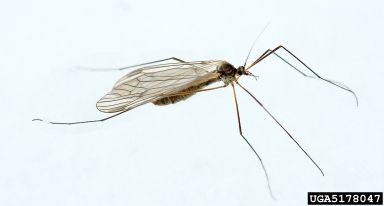Common Crane Fly

Photo by David Cappaert
Common Name: Common crane fly
Scientific Name: Tipula oleracea
Origin: Europe
Description
This invasive crane fly can be differentiated from native species by the dark band along the leading edge of the wing adjacent to a light band. Adult flies are about 2.5 to 3.0 cm long with larvae being about 3 to 4 cm. The survival of eggs and larvae is dependent on wet conditions.
Habitat
These invaders are found in grass-based systems. They are dependent on moist soil with poor drainage.
Threat
The larvae, known as leatherjackets, can be destructive to lawns, agricultural fields, golf courses, and other grass-based systems. Because of feeding and disturbance of rooting of grass, these insects often produce bare patches and yellowing spots on grass.
Management
An effective form of management of these invaders is raking up the larvae just as they begin to emerge from the ground. Because the larvae are sensitive to dry conditions, limiting irrigation and controlling moisture levels can help control population sizes. For larger infestations, insecticides may be used during egg laying season or just as the larvae emerge from the soil.
Distribution: View Map
Wide spread in New York State, including Monroe, Ontario, Onondaga, Seneca, and Wayne Counties.

